Making bus service sexy and more equitable
A comment on an earlier thread reminded me that for a few years say from 2006-2009, I was constantly suggesting that bus service could be rebranded and repositioned through switching to the kind of double decker buses used in cities like London.
This was item 20 in the blog entry revised revised People's Transportation Plan/2008.
Improve the bus service. I say do this before thinking about streetcars. We need to make bus service exciting and sexy, in order to boost transit use. I recommend better marketing and wayfinding systems, better bus shelters (coming) and waiting stations, and probably sexier buses, which to my way of thinking, would be double deckers, on routes that could accommodate them.
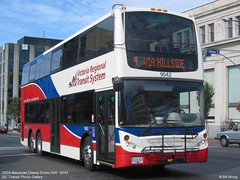
Double decker bus in Victoria, BC. Photo by Bill Wong.
-------
Double deckers are available in three sizes from Alexander Dennis, 37 feet, 40 feet, or 42 feet long and either 13.77 or 14.1 feet high. The Enviro 500 is marketed in North America and is used as a tourist bus in many markets, including DC.
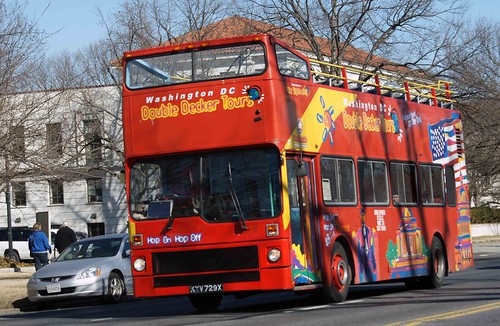
Tourist bus in DC. Flickr photo by Durham Skywriter.
But I guess after awhile I forgot about it because the Council staffer that followed up on this told me that bus drivers prefer the articulated buses because they have a slightly smaller turning radius and not all bus depots could accommodate taller buses.
Plus, in suburban locations, there would have to be significant changes to how utility and traffic signal infrastructure crosses intersections in order for taller buses to be able to travel on the roads--for the most part in DC, traffic signals and electric lines don't "cross the street" in the same way they do in the suburbs so this isn't a problem. But in suburban settings, the cost of resetting traffic signals and utility wires would be a large initial cost making it difficult to switch to double deck buses.
(In DC there would be an issue on some routes when buses are forced to move off the route because of street closures, and frequently those alternative roads have wire infrastructure issues.)
But this should be revisited. As an example, just last week OC Transportation in Ottawa, Ontario began introducing double deck buses on commuter routes, replacing articulated buses, which take up more room at bus stops and carry fewer riders. See the CTV story "OC Transpo unveils new double-decker buses." The story has a nice video showing the buses on city streets and interviews with transit riders. OC Transportation expects a $9 million reduction in operating costs from the the switching to double deck buses on those routes.
I like the message on the bus directional sign: the way to go in Canada's Capital. Caption: 75 of the high-capacity double-decker buses should arrive by next spring. Photograph by: Pat McGrath, Ottawa Citizen.
Just as the buses look cool and are the same type of bus that is associated with London ("Cool Brittania"), it's not unlike how the attractive graphic design, service legibility (service roughly every 10-12 minutes), and slightly more attractive and design forward buses when compared to traditional transit buses, rebrands and repositions the DC Circulator (and the Charm City Circulator in Baltimore, see "Circulator bus grows, attracts mix of riders" from the Baltimore Sun) bus service as desirable enough for people to ride the bus.
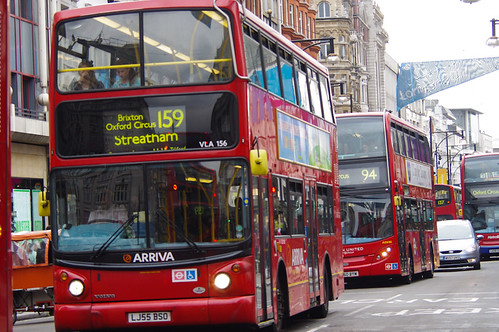
Buses Line up on Oxford Street. Flickr photo by DJ Fleer.
All the people in DC seem to want "Circulator" buses in their neighborhoods, while they don't advocate all that much about Metrobus service.
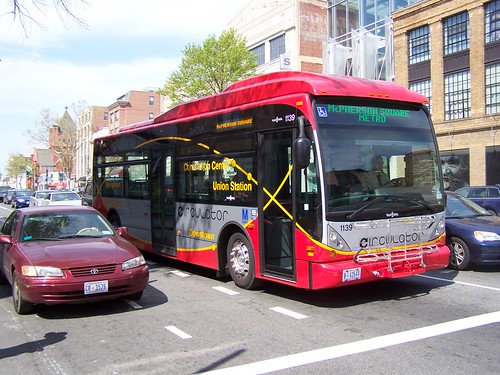
30-foot buses were used to launch service when Circulator routes were added in residential areas, where the ridership was expected to be significantly lower than on the original routes.
Bus service more generally needs a reboot and I think double deck buses might be the only way to really do it, all the focus on "bus rapid transit" notwithstanding.
(The fact is that bus rapid transit is focused on longer distance trips, albeit for choice riders, and the reality in the US so far is that it hasn't so significantly increased ridership in the communities that it has been introduced so that transit is significantly repositioned.)
Introduction of double deck buses, simultaneous with some other key improvements to bus service and transit marketing and information provision, could significantly rebrand and reposition bus service as a desirable public service and civic asset.
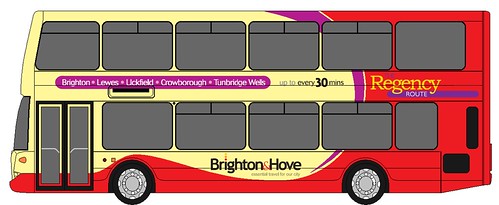
Buses in Brighton and Hove also are branded with specific routes--the main destinations and the frequency of the service on the route.
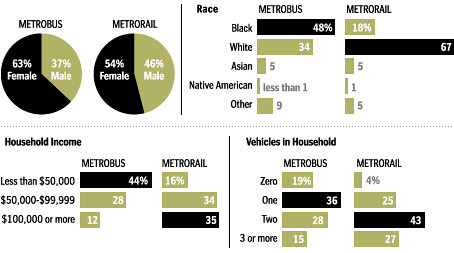 Right: transit rider demographics, Washington metropolitan area. Washington Post graphic, 2005.
Right: transit rider demographics, Washington metropolitan area. Washington Post graphic, 2005.Bus service improvement as an equity initiative
Transit can be very successful in center cities with strong central business districts because traffic congestion and high prices for parking (although some firms subsidize parking) can make transit a better option for many people.
But the farther out people live, the less likely it is that efficient transit can be provided. Still people ride commuter rail and commuter buses.
Notions Capital calls our attention to this piece, "Revisiting bus stigma," from the Jacobin blog, which makes the argument that as long as transit service is mostly seen as a service for the poor, and choice riders own and use cars, transit service will continue to decline because it isn't a service used by all.
I agree. But it's problematic because for transit service to be attractive--it should be faster and cheaper than driving. From the article:
Since the 1950s, US policymakers and politicians have built highways and parking spaces on what seems like every corner of the country. Meanwhile, urban transit systems from Boston to San Francisco have suffered massive disinvestment and stigmatization despite their numerous positive externalities (notably, decreased pollution and gridlock) and increasing ridership. While subway and light-rail systems are appreciated and used by many affluent urban residents, bus systems, largely the modes of last resort for poor and underserved communities, are stigmatized by these same urbanites. Ludacris’ character in Crash, a young black man hyper-aware of societal racism, disparages buses as humiliation vehicles for the least fortunate Angeleno people of color. ...
Like the struggles over education reform, affordable housing, and other public amenities, the disinvestment in public transportation highlights an increasing disregard for those things that allow this country to produce and function on a very basic level. Public goods like these can only function effectively if they are available to everyone. Otherwise, like welfare in the 90s, they’ll be stigmatized and gradually eliminated by the ruling class. What we need is not to ignore the stigma of buses, but to erase it by creating a public transportation system that refuses to define riders’ needs by their class background.
Double deck buses would be seen as an upgrade and could make service more comfortable for current customers first, and new rider-customers second.
Other bus service improvements
The best way to reposition bus service as an attractive service (currently fixed rail transit vehicle-based services--light rail, streetcars, subways, and railroads are preferred over bus service by choice riders and typically riders of buses comprise lower income segments of the population) would be to introduce new buses with a simultaneous re-boot of other components of the bus transit experience. (This is also relevant to my comments in the GGW entry "More people will only ride buses if information gets better," that there needs to be an agenda for change, not just whining.)
This in fact is supposed to be a key component of bus rapid transit, especially with priority lanes, special bus shelters, and prepayment of fares in order to speed boarding.
Improvement agenda for bus service, proposed as a complement to the introduction of double deck buses
1. Improve bus transit waiting environments
2. Improve bus transit marketing
3. Create a priority bus lane network in the core of the city
4. Add Night Owl bus service along subway lines during the hours that the subway service is closed
5. Improve wayfinding and transit information
6. Augment on-board bus announcements and information on schedules, signage, etc., with landmark and destination information
7. Create "Mobility" stores as part of transportation demand management programming
8. Incorporate neighborhood history information and public art elements into bus shelters
• Improve all "transit waiting environments" in the city. Bus shelters (and subway stations) are the most visible physical elements of the transit system. Their quality--positive and negative--communicates the extent to which a community values transit. In the DC area, the difference (DC's bus shelter program is a positive exception) between the quality of subway stations versus bus stops and shelters definitely communicates that subway service is prioritized over bus service. In many communities, especially those which only provide bus service, the quality of transit waiting environments is abysmal.
DC's bus shelter program is only for bus shelters on city streets. It doesn't impact WMATA bus shelters at transit stations (most of which are in need of an upgrade), and it doesn't impact bus stops that don't already have bus shelters.
Sub-standard bus stops communicate to people that transit isn't valued.
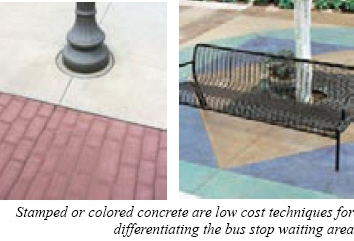

Bus stop, 900 block of Monroe Street NE.
Transit waiting environments, a report for the Greater Cleveland Rapid Transit Authority, studied transit waiting environments in great depth.
Based on ridership, land use context, and the presence of activity generators, recommendations were made to categorize bus stops as one of four types and outfitting each type of stop with an appropriate set of desired amenities.
Surveys of regular and infrequent riders determined the types of amenities desired according to the stop context and environment.
The most important amenities, in order of priority, were: (1) Information on bus arrival and the frequency of service; (2) Lighting (at night); (3) Shelter; (4) Seating; (5) Heating in bus shelters; (6) Paved waiting surfaces; (7) Trash cans; (8) Area maps; (9) Bike racks; and (10) Landscaping.
Basic stops (Type 1) would include information on the route(s) served, a consistently identifiable bus stop utility pole, lighting, a paved waiting pad, and a trash can. Type 1 service was recommended for 43 percent of the stops.
Type 2 stops would include seating and bike racks and were applicable for 26 percent of stops based on a calculation of density and school proximity.
For type 3, in areas of mid- to high-densities, additional amenities would include a shelter with on-demand heating (Phoenix, with different needs, is adding on-demand misting in the summer, see the blog entry "NYC temporary water station and other hot weather treatments"), a more detailed information sleeve, additional seating, and strategies to encourage transit-oriented development in the area. This type was proposed for 20 percent of the total locations.
Type 4, designed for key community destinations, was proposed for 6% of stops, and in addition to all previous amenities, would include public art, a transit system map, and real-time bus arrival display. The final type, reserved for less than 1% of stops that were determined to be regional gateways, would incorporate unique artistic elements to welcome visitors.
• Improve bus transit marketing. While I have written plenty about this over the years, the report From Here to There: A Creative Guide to Making Public Transport the Way to Go from EMBARQ, provides a more definitive, structured and thorough guide for rethinking and improving transit marketing.
From the webpage:
The purpose of the guide is to help transit agencies develop strong and successful strategies to achieve three important goals:
1. Attract new users that currently use private transport, such as cars and motorcycles,
2. Retain existing public transport users who might feel compelled to buy a private vehicle, and,
3. Secure political and financial support from government officials.
By taking a cue from the private sector, which routinely and successfully influences consumer behavior, the report applies eight branding, marketing and communications tactics to the public transport sector.
• Brand and identity
• Internal communication
• User education
• User information systems
• Marketing campaigns
• Public relations and external communications
• User feedback systems
• Online engagement
For the most part transit in the Greater Washington area is promoted in a very stodgy way. Shake things up... Start by changing the graphic design scheme of the buses and Metro signage. The new Metrobus graphic design is updated, but not significantly better than the design it replaced.
Make the buses and signage pop graphically as much as the subway map already does.
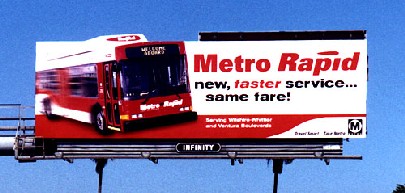
Los Angeles has done some interesting transit promotional marketing. But we need to do the same kind of marketing in office buildings, public places, hotels, and transit stations.
Pittsburgh uses buses as rolling billboards to promote transit.
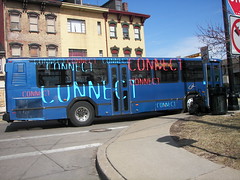
You can really see the difference in how websites from Transport for London and the San Francisco Municipal Transportation Agency communicate. They focus on optimizing mobility and communicating about multiple modes. Although the WMATA Ride Guide is great, people are using mobile phones and expect to be able to get transit information the way they want to, not the way that we are providing it to them. (E.g., people want transit information within Google Maps, etc.)

Arlington County transit promotion ad in a 2005 issue of the Arlington-Alexandria Extra edition of the Washington Post.
Add transit information displays to public buildings such as the main branch of the Public Library, Reeves Center, National Airport, Union Station, visitor centers, etc.
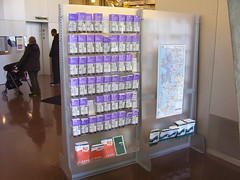
Transit information rack, Seattle Public Library.
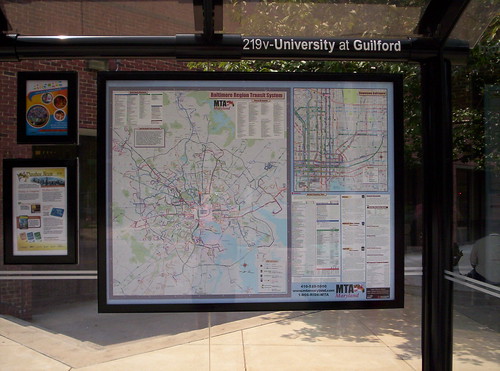
Besides providing maps, MTA bus shelters in Baltimore have signboards for marketing and community information (the smaller signs to the left in this photo).
• Create a priority bus lane network in the core of the city. In the core of the city, more people are moved more efficiently on buses than they are in motor vehicles. Bus service should be prioritized to acknowledge this.
There are a couple ways to do this. One, such as in Minneapolis with the Nicolett Transit Mall or the 16th Street pedestrian and transit mall in Denver, is to eliminate other motor vehicle traffic by the creation of a transit mall. But transit-exclusive malls can be pretty uncongenial and are not necessarily recommended.
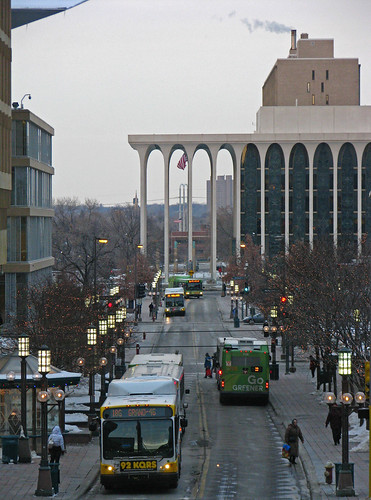
Winter from a Nicollet Mall Skyway. Flickr photo by MSPdude.
The other is to create a set of prioritized bus lanes, even to the extent of providing curbs and other separators, with the traditional road network. Doing this in London, along with other improvements to pedestrian crossings, installation of safety cameras, and enforcement, found that waiting times for passengers reduced by about 33%; ridership increased by 20%, and reduction in trip time variability for both buses and motor vehicles.
A priority lane network, especially east-west, where the bulk of the transit service is provided, should be created to extent possible, in Downtown DC especially.
-- Draft Bus Priority Treatment Guidelines, Metropolitan Washington Council of Governments
-- Shared-Use Bus Priority Lanes on City Streets: Case Studies in Design and Management, Mineta Transportation Institute, San Jose State University (includes case studies from many cities such as London, Paris, Los Angeles, and New York City)
• Add Night Owl bus service on subway routes during the periods when the system is closed. See the recent blog entry "Overnight transit service."
• Improve transit wayfinding information. It's getting better (e.g., improved maps from WMATA are installed at many bus shelters and at all bus shelters at Metro stations), but transit stations need to be better utilized as "touchpoints" for marketing the use of the transit system, for everyone but especially for tourists.
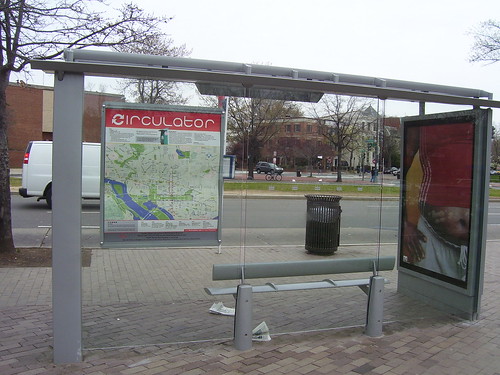
Looking into a bus shelter from behind.
Bus shelters are a key place for this because they are a prominent element of the streetscape. And as people walk and ride past shelters, and whether or not they use them, they still can read the information.
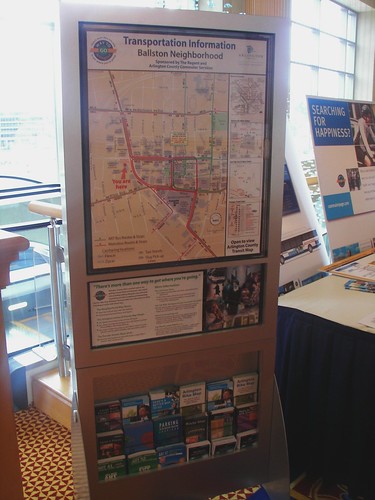
Arlington has information systems for transit that it places in office buildings and public places. Portland and Seattle have extensive transit information systems placed in major public buildings and gathering places.
While this is covered in the point above about improving transit waiting environments, it is worth repeating that all bus stops should have complete schedule information and a map. Arlington County has achieved this for all of their bus stops. (WMATA is improving the provision of information at bus stops, but not all stops have information necessarily, the provision of information hasn't been upgraded on many routes, and all the routes serving particular stops aren't necessarily included on the information that is provided.)
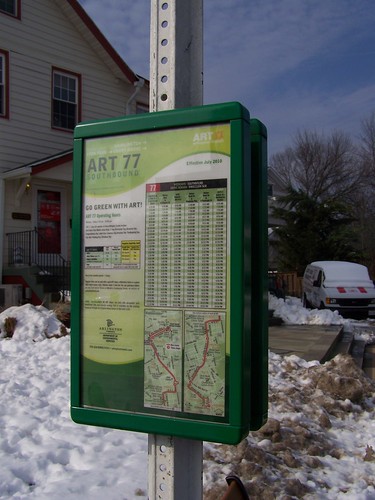
Put maps on buses, such as is done in New York City.
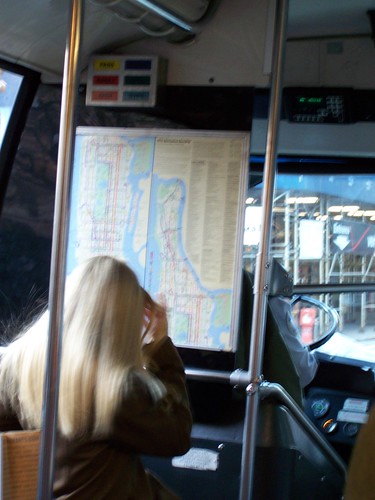
Better provision of schedule change information should also be a priority, and notices should be placed on every bus stop on an affected route. (Note that it does appear that WMATA has started to do this. Most transit systems do a bad job on this.)

Bus shelters/kiosks at the surface, at subway stops (which in the Cleveland typology would be Type 3 and Type 4 stops), should include integrated transit schedule information for buses and subway service (and maybe bikesharing).
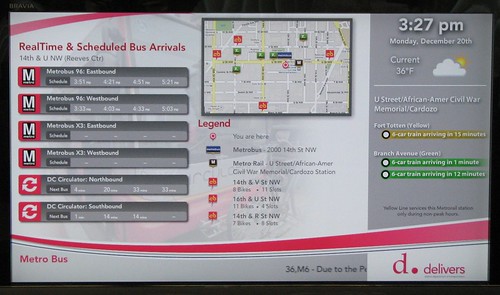
DDOT Multimodal transit information display. Flickr photo by Erik Weber.
• Augment on-board bus announcements, map, schedule, and sign information to incorporate more information on local landmarks and destinations (such as the White House) as discussed in "Transit riding as customer service"
Left: Central London bus and tourist map, Transport for London. The map shows key destinations on various routes, which for the most part, DC bus maps do not do.
• DC needs to create "Mobility" stores to market walking, bicycling, and transit to DC residents and commuters, but as a lifestyle, not merely as mode shift for commuters.
This extends Arlington's Commuter Store beyond the overwhelming focus on commuters towards encouraging residents (and commuters) to utilize transit, walking, bicycling as the preferred way to get around for all kinds of trips, not just to get to work. (Also see the blog entry, "Disruptive Innovation (One Again).)
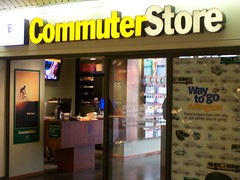
• Allow bus shelters to become primary elements in communicating neighborhood history and for public art and commercial district information. This was discussed in 2006 in "Bus Shelter Planning," as well as other entries.
Granted, the neighborhood history trail program of Cultural Tourism DC is already doing something similar, but this could be augmented and extended in different ways to include bus shelters.

Brightwood's Automobile culture, history trail sign.
Generally, some funds should be allocated to neighborhoods for doing this. For example, in commercial districts with business improvement districts, usually they will develop and implement directory information such as maps (Golden Triangle BID) and more general directory information (Adams Morgan BID). But dis- or un-organized business districts need help to pull this off. Their shelters just have empty sideboards.
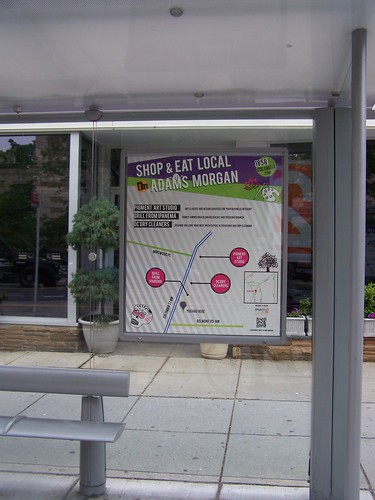
Above: local business district information sign, Adams Morgan. Below: map sign in the Golden Triangle Business Improvement District on a Connecticut Avenue bus shelter.
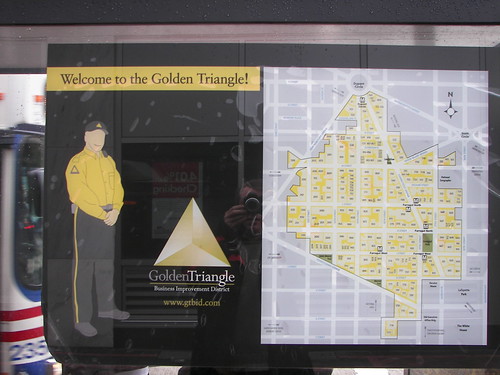
Some transit systems do provide some transit history interpretation and communication. The bus system in Lancaster, PA has interpretation boards at their main bus station. Baltimore's light rail has some history signs along the route, and there is an interpretation in an old trolley waiting station now serving as a bus shelter on Charles Street in the Guilford neighborhood. Such information can be incorporated also as part of this improvement element, or in the general element about adding the provision of art and neighborhood history to bus shelters.
Stained glass bus shelter, Walnut Street, Philadelphia
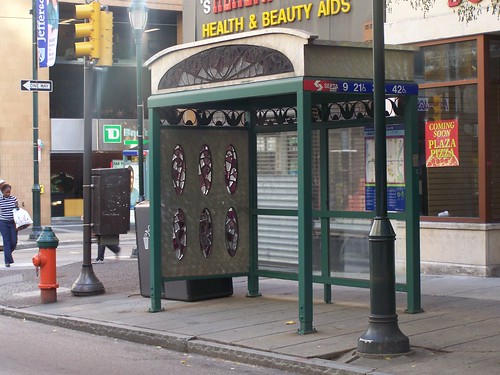
Not a bus shelter, but an inspiration, La Casita, created by Pepon Osorio, has photos of Philadelphian Latinos imprinted into the glass of the structure. Photo by Glassblade.
Labels: car culture and automobility, equity, transit infrastructure, transit marketing, transportation planning

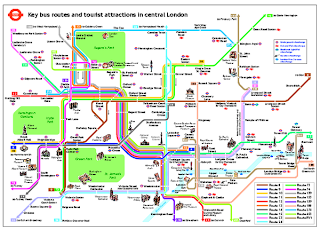




9 Comments:
TTC to stop posting printed schedules at bus stops.
https://www.thestar.com/news/gta/2016/12/23/ttc-criticized-for-removing-printed-bus-schedules.html
Chicago's Active Transportation Alliance releases report on making bus transit more effective, to increase ridership:
http://activetrans.org/sites/files/SpeedingupBuses.pdf
Nov. 2017
https://www.thestar.com/news/gta/2018/05/31/study-says-improving-bus-service-is-the-best-way-to-boost-transit-ridership.html
Also my 2017 post, can bus service ever be cool/GoTransit + Boston
Invest in the Ride report from McGill:
http://tram.mcgill.ca/Research/Publications/Transit_Ridership_overtime.pdf
Bus charter bus rental Tacoma , Are you in a mood to go on a road trip with friends and family, but a budget and conveyance constrain is limiting your path? Nothing is impossible, now fulfill all your plans with Bus Charter Nationwide USA.
nice information.Have a medicine website. there is a medicine that seems to work, please check out website.Take this medicne as advised by the doctor that are easily available at the online medicine store in USA.
Great Post! Thanks for sharing such beautiful information with us. Please keep sharing.
Please visit CHICAGO PARTY BUS
Great post! MYLO Rides offers some of the most reliable Bus Transportation Services I've used in Mumbai. Timely, clean, and comfortable—perfect for daily commuting without the stress of driving or waiting endlessly for a ride. Visit us for more!
Bus Transportation Services
This is such a refreshing take on public transportation! Making bus service both sexy and equitable is exactly the kind of forward-thinking approach cities need. When buses are designed to be efficient, comfortable, and visually appealing, they stop being a last resort and become a preferred choice. At the same time, focusing on equity ensures that reliable transport is accessible to all communities, not just a privileged few. It’s exciting to see ideas that blend design, dignity, and inclusivity into something as essential as mobility. Here’s to reimagining the future of bus travel! School bus rental Singapore
Great post! Finally, reliable bus transportation services near me! MYLO Rides has made city travel stress-free and affordable. Loving the punctuality and comfort—definitely recommending this to friends and coworkers. Visit us for more!
Bus Transportation Services Near Me
Post a Comment
<< Home